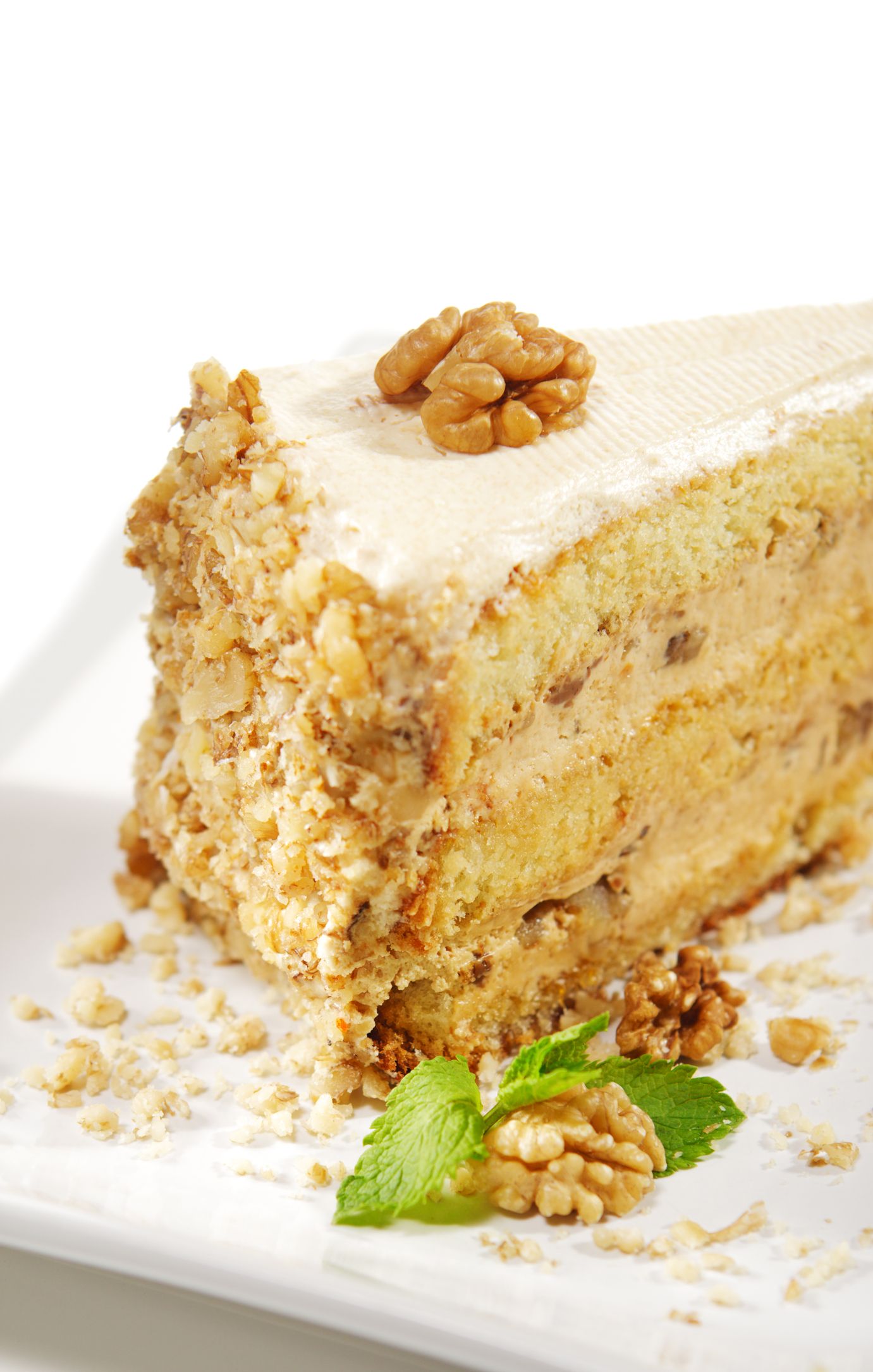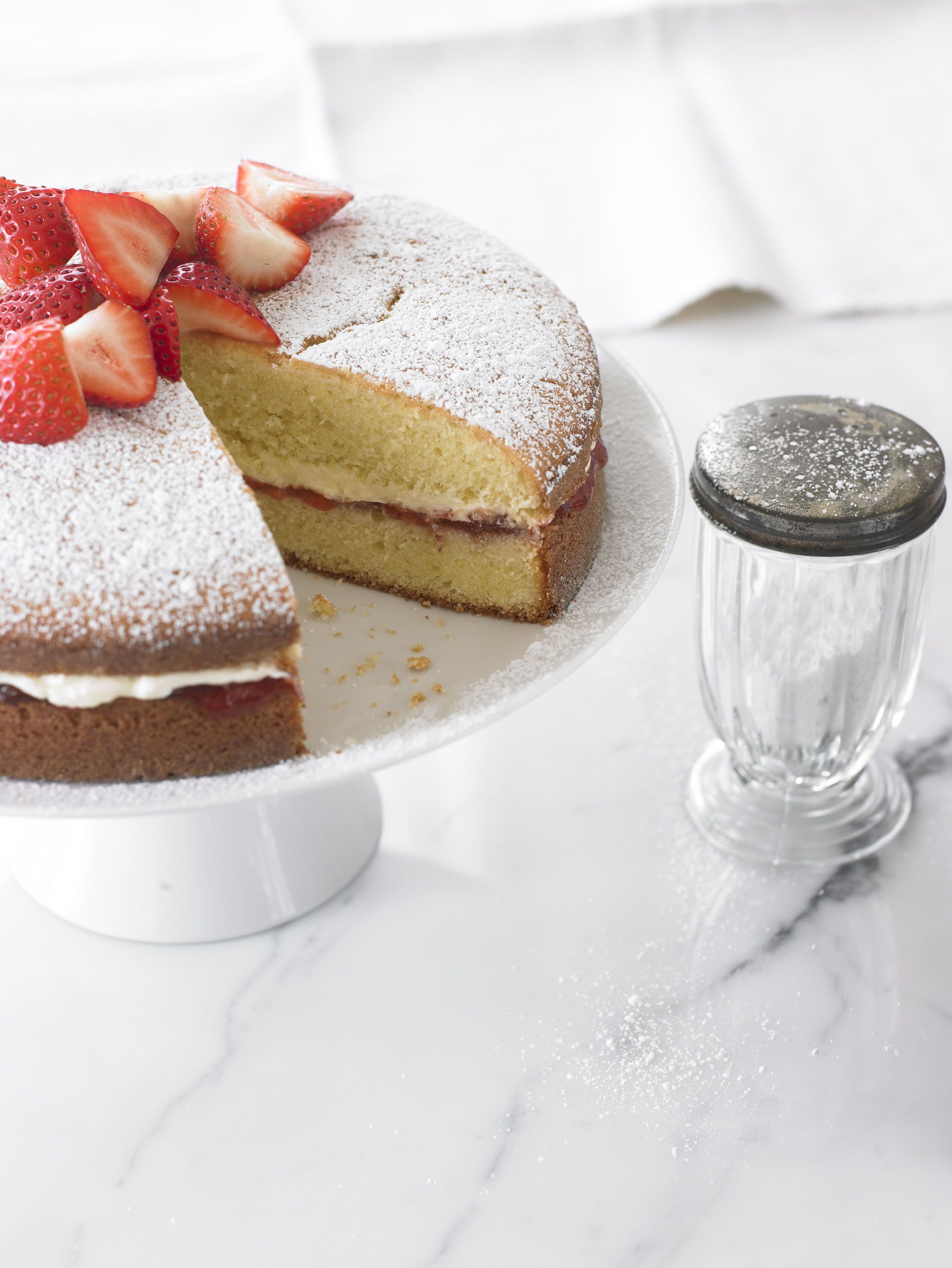Mother’s Day, a national holiday celebrated on the second Sunday of May in the United States, was created by Anna Jarvis in 1908 to recognize the contributions that mothers and mother figures make to American society. President Woodrow Wilson named it an official holiday in 1914. My mom is no longer with us, but as we celebrate this very special day on Sunday, I remember her for the wonderful cook she was, especially her cakes. So if you haven’t already purchased wine, flowers, or chocolates for the mother or mother figure in your life, bake her a cake!
COFFEE & WALNUT CAKE
Serves 10
This Anglo-Irish “gateau,” as some like to call it, is a classic cake that ranks among the most popular teatime cakes in the United Kingdom and Ireland. It frequently appears on tea trays and cake trolleys in Irish country house hotels and is a long-standing favorite with cooks hosting tea at home. My mother made it often using instant coffee rather than espresso powder. You’ll find this recipe and other tempting sweets in my new cookbook Delicious Ireland. To order a signed copy, visit irishcook.com
For the cake
2 teaspoons instant espresso granules or powder
1/4 cup warm water
8 ounces butter, at room temperature
1 cup sugar
4 large eggs
2 cups self-rising flour
1 1/3 cup chopped walnuts, plus more for decorating
8 to 12 walnut halves, for decorating
1. Preheat the oven to 350ºF. Coat the bottom and sides of two 8-inch cake pans with no-stick baking spray with flour.
2. In a small bowl, mix the espresso granules with water; stir to dissolve.
3. In the bowl of a stand mixer fitted with a paddle attachment (or with a hand mixer), beat the butter and sugar on medium speed until light and fluffy. Add the eggs, one at a time, alternating with the flour. Beat until blended and smooth. Stir in the nuts and espresso mixture. Divide the mixture into the prepared pans.
4. Bake the cakes for 28 to 30 minutes, or until a skewer inserted into the center comes out clean. Let cool in the pans for 10 minutes. Invert cakes onto a wire rack; return to upright.
For the icing
6 ounces unsalted butter, at room temperature
Pinch of salt
4 1/2 cups confectioners’ sugar
4 tablespoons brewed espresso
1, In a large bowl, beat the butter, salt, confectioners’ sugar, and espresso until smooth. Brush any loose crumbs from the cake layers. Place one layer, rounded side down, on a serving plate.
2. With an offset spatula, spread 1/3 to 1/2 cup of the icing over the first layer to within about 1/4 inch of the edge. Place the second cake layer, rounded side up, on top. Coat the side of the cake with a thin layer of icing. Refrigerate the cake for 20 minutes. Spread the remaining icing on top and around the side. Press remaining chopped walnuts on side. Decoratively place the walnut halves around the top of the cake before cutting into slices.

[Photo by Boris Ryzhov]
VICTORIA SPONGE
Serves 8 to 10
This traditional cake consists of jam and whipped cream sandwiched between two sponge cakes. The top of the cake is generally not iced or decorated except for a sprinkling of confectioners’ sugar, sometimes over a doily to create a lacy pattern. The cake is named in honor of Queen Victoria, who spent time at her residence on the Isle of Wight following the death of Prince Albert in 1861. To inspire the monarch to get back into the swing of civic duties, she was encouraged to host tea parties, at which a sponge cake like this was served. “Victoria Sponges” became fashionable throughout England and Ireland and became the measure of the home-baker.
For the cake
6 ounces butter, at room temperature
3/4 cup sugar
4 large eggs, beaten
2 cups self-rising flour
1 teaspoon baking powder
1. Preheat the oven to 325°F. Coat a 9-inch round pan with no-stick baking spray with flour.
2. In a medium bowl, beat the butter and sugar with an electric mixer on medium speed until light and fluffy. Add the eggs, one at a time, beating well after each addition. Whisk in the flour and baking powder until smooth. Transfer the mixture to the prepared pan.
3. Bake the cake for about 30 minutes, or until the top is golden and a skewer inserted into the center comes out clean. Let cool on a wire rack for 15 minutes.
4. Invert the cake onto a serving plate; return to upright. With a serrated knife, cut the cake in half horizontally.
For the filling
1/2 cup strawberry or raspberry jam
2/3 cup heavy cream, whipped
Confectioners’ sugar, for dusting
Fresh strawberries, for garnish (optional)
1. Spread the bottom half of the cake with strawberry or raspberry jam. Spread the whipped cream over the jam; replace the top half of the cake.
2. Place a 9-inch doily on top of the cake; lightly sift confectioner's sugar on top. Carefully remove the doily, leaving a lacy pattern on the cake. Cover and refrigerate cake until serving time. Garnish with fresh strawberries, if desired.
CARROT CAKE WITH CREAM CHEESE ICING
Serves 24
This no-fuss carrot cake is frosted in the pan.
For the cake
2 1/4 cups all-purpose flour
2 teaspoons baking soda
2 teaspoons salt
2 teaspoons cinnamon
2 cups sugar
1 1/2 cups canola oil
4 large eggs
3 cups shredded carrots
1 cup chopped walnuts or pecans
1. Preheat the oven to 350°F. Coat a 9 x 13-inch pan with no-stick baking spray with flour.
2. In large bowl, whisk together the flour, baking soda, salt, and cinnamon.
3. In another large bowl, beat the sugar, oil, and eggs with an electric mixer on medium speed until light and fluffy. Add the flour mixture; beat on low speed for 1 to 2 minutes, or until blended; fold in the carrots and nuts. Transfer the batter to prepared pan.
4. Bake the cake for 40 to 50 minutes, or until a skewer inserted into the center comes out clean. Let cool completely in the pan.
For the icing
8 ounces cream cheese, at room temperature
2 ounces unsalted butter, at room temperature
2 teaspoons vanilla
2 cups confectioners’ sugar, sifted
1. In a large bowl, beat the cream cheese, butter, and vanilla with an electric mixer on medium-high speed for 1 to 2 minutes, or until smooth. Scrape down the sides of the bowl. Add the confectioners’ sugar. Beat for 1 to 2 minutes, or until fully incorporated and smooth. With an offset spatula, spread the icing evenly over the cake; refrigerate until icing is firm.
2. To serve, cut the cake into 4 rows lengthwise by 6 rows across.
Margaret Johnson’s “Recipes” page also includes “Ireland Hopping: Adventures in Food, Drink, and Travel.” For further details on her work, or to order a signed copy of any of her cookbooks, visit irishcook.com.









